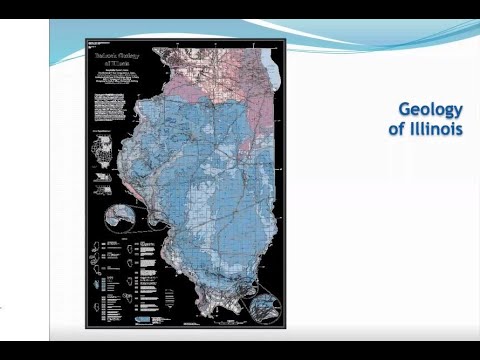
What are some unique geological features in Northern Illinois?
If you’re a nature enthusiast or simply curious about the Earth’s fascinating formations, Northern Illinois has a range of unique geological features to explore. As an authority on the subject, let me take you on a virtual tour of some of the most captivating geological wonders in this region. Prepare to be amazed!
1. Starved Rock State Park: Located along the Illinois River, Starved Rock State Park is home to stunning sandstone canyons and towering bluffs. These canyons were formed over thousands of years through a combination of glacial activity and water erosion. Explore the park’s numerous hiking trails and witness the breathtaking beauty of nature’s handiwork.
2. The Illinois River Valley: The Illinois River Valley is a prime example of the power of water in shaping the landscape. Over time, the river has carved out a deep and wide valley, creating a unique and picturesque scenery. Take a boat tour or drive along the river’s edge to fully appreciate the scenic vistas and the geological processes at work.
3. The Rockford Ice Age Trail: If you’re interested in the remnants of the last Ice Age, the Rockford Ice Age Trail is a must-visit. This trail showcases the glacial landforms left behind by the Wisconsin Glacier, including kettle lakes, moraines, and drumlins. Embark on a journey through time as you walk in the footsteps of ancient ice sheets.
4. The Niagara Escarpment: Stretching from Wisconsin through Northern Illinois, the Niagara Escarpment is a geological wonder that offers a glimpse into the Earth’s ancient history. This limestone ridge was formed over millions of years and is home to unique plant and animal species. Explore the escarpment’s trails and marvel at its geological significance.
5. The Galena-Platteville Dolomite: In the northwestern part of Northern Illinois, you’ll find the Galena-Platteville Dolomite, a rock formation that dates back over 450 million years. This formation is renowned for its beauty, with intricate patterns and vibrant colors. It also contains fossils that provide valuable insights into ancient marine life.
6. The Kankakee River State Park: The Kankakee River State Park showcases the diverse geological features of Northern Illinois. From sand dunes and marshes to limestone bluffs and glacial remnants, this park is a treasure trove of natural wonders. Hike, fish, or simply enjoy a picnic while immersing yourself in the region’s geological splendor.
7. The Illinois Beach State Park: Situated along the shores of Lake Michigan, the Illinois Beach State Park boasts unique geological features shaped by both water and ice. Explore the sandy beaches, dunes, and swales while learning about the geological processes that have shaped this stunning landscape.
8. The Mississippi Palisades State Park: While technically just across the border in Northwestern Illinois, the Mississippi Palisades State Park is worth mentioning for its awe-inspiring geological formations. This park features towering limestone cliffs, deep canyons, and breathtaking views of the Mississippi River. Hike along the trails and witness the power of erosion in action.
In conclusion, Northern Illinois is a treasure trove of unique geological features that showcase the Earth’s fascinating history. From sandstone canyons and glacial landforms to limestone ridges and ancient rock formations, the region offers a diverse range of natural wonders to explore. So grab your hiking boots, pack your camera, and embark on a journey through time as you witness the beauty and grandeur of Northern Illinois’ geological marvels.
Discovering Illinois’ Hidden Gems: Exploring the Fascinating Geological Sites Across the State
Discovering Illinois’ Hidden Gems: Exploring the Fascinating Geological Sites Across the State
Are you ready to embark on a thrilling journey through the geological wonders of Northern Illinois? From ancient rock formations to stunning waterfalls, this region is teeming with unique geological features that will leave you in awe. So grab your hiking boots and get ready to explore Illinois’ hidden gems!
1. Starved Rock State Park: This iconic park boasts towering sandstone canyons that were formed over 425 million years ago. As you hike along the trails, you’ll encounter breathtaking waterfalls cascading down the cliffs, such as French Canyon and St. Louis Canyon. These canyons were carved out by the erosive force of glaciers during the last Ice Age, leaving behind dramatic rock formations and scenic vistas. Don’t miss the opportunity to climb up to the top of Starved Rock, the park’s namesake, for panoramic views of the Illinois River.
2. Matthiessen State Park: Just a few miles south of Starved Rock, you’ll find another geological wonderland at Matthiessen State Park. This hidden gem is known for its unique rock formations, including the famous Dells Area. Here, you can explore a labyrinth of canyons, caves, and waterfalls, all carved out by the erosive forces of the Vermilion River. The stunning Cascade Falls is a must-see, with water cascading down a series of steps and creating a picturesque scene. As you wander through the park, keep an eye out for wildlife, as Matthiessen is home to a diverse range of plants and animals.
3. Illinois Beach State Park: If you’re looking for a different kind of geological feature, head to Illinois Beach State Park along the shores of Lake Michigan. This unique park is home to the largest expanse of natural sand dunes in Illinois. These towering dunes were formed thousands of years ago by wind and water erosion, creating a stunning landscape that stretches for miles. Take a leisurely stroll along the beach, or hike through the dunes to get a closer look at this geological marvel. Don’t forget to bring your binoculars, as the park is also a haven for birdwatchers.
4. Mississippi Palisades State Park: Located along the mighty Mississippi River, this state park is a geological wonderland waiting to be explored. The park is named after the towering limestone bluffs, or palisades, that line the river. These cliffs were formed over millions of years by the erosive force of the river, creating a dramatic backdrop for outdoor enthusiasts. Hiking trails wind their way through the park, offering breathtaking views of the river and the surrounding bluffs. Keep an eye out for unique rock formations, such as the Devil’s Punch Bowl and Indian Head Rock, as you explore this hidden gem.
5. Garden of the Gods: While technically located in Southern Illinois, this natural wonder is worth the trip for any geology enthusiast. The Garden of the Gods is a surreal landscape of towering sandstone rock formations that have been sculpted by wind and water over millions of years. As you hike through the park, you’ll be surrounded by stunning views of the Shawnee National Forest and the Ohio River. Don’t miss popular rock formations like Camel Rock and Anvil Rock, which have become iconic symbols of this geological masterpiece.
So there you have it, a glimpse into the unique geological features that await you in Northern Illinois. From ancient canyons to towering cliffs, these hidden gems offer a fascinating insight into the Earth’s geological history. So pack your sense of adventure and get ready to discover Illinois’ hidden treasures!
Unveiling the Enigmatic Past: Unraveling the Geological History of Illinois
Unveiling the Enigmatic Past: Unraveling the Geological History of Illinois
Have you ever wondered about the geological wonders of Northern Illinois? Well, you’re in for a treat! Northern Illinois is home to some unique geological features that will leave you in awe. In this article, we will delve into the fascinating world of Illinois’ geological history and explore the wonders that lie beneath the surface.
So, grab your geological pickaxe and let’s start uncovering the mysteries of Northern Illinois!
1. The Illinois Glacial Trail: One of the most prominent features of Northern Illinois is the Illinois Glacial Trail. This trail stretches over 31 miles and takes you through a landscape shaped by the mighty glaciers that once covered the region. As you walk along the trail, you’ll come across kettle lakes, moraines, and eskers, all remnants of the glacial activity that occurred thousands of years ago. It’s like stepping back in time and witnessing the powerful forces of nature that shaped the land we see today.
2. Starved Rock State Park: Nestled along the Illinois River, Starved Rock State Park is a geological wonderland waiting to be explored. This park is famous for its towering sandstone canyons, carved over centuries by the flowing waters. As you hike through the park, you’ll encounter breathtaking waterfalls, stunning rock formations, and picturesque overlooks. It’s a paradise for nature enthusiasts and geology lovers alike!
3. The Mississippi River: While the Mississippi River may not be exclusive to Northern Illinois, its impact on the region’s geological history cannot be ignored. The mighty Mississippi has played a significant role in shaping the landscape of Northern Illinois over millions of years. Its powerful currents have carved out valleys, created floodplains, and deposited layers of sediment, resulting in a diverse and rich geological tapestry.
4. The Great Lakes: Although not located solely in Northern Illinois, the Great Lakes have had a profound influence on the region’s geological features. Lake Michigan, in particular, has shaped the coastline of Northern Illinois, eroding and depositing sediment along its shores. The dunes found along the lakefront are a testament to the dynamic nature of this geological process. Exploring these sandy landscapes is like stepping into a mini desert right in the heart of Illinois!
5. Niagara Escarpment: Last but certainly not least, we have the Niagara Escarpment. This geological feature stretches from Wisconsin to Niagara Falls, passing through Northern Illinois. The escarpment is a long, steep slope formed by the erosion-resistant rock layers that once covered the area. It’s a geological marvel that offers stunning views and a glimpse into the ancient history of the region.
As you can see, Northern Illinois is a treasure trove of unique geological features. From glacial trails to sandstone canyons, there’s something for everyone to explore and discover. So, the next time you find yourself in Northern Illinois, don’t forget to take a moment to appreciate the wonders that lie beneath your feet. Happy exploring!
Unveiling the Geological Secrets: Exploring the Ancient Origins of Illinois through its Oldest Rocks
Unveiling the Geological Secrets: Exploring the Ancient Origins of Illinois through its Oldest Rocks
1. The Rock River Valley: The Rock River Valley is a unique geological feature in Northern Illinois. It is a picturesque landscape formed by the erosive power of the Rock River over millions of years. The river has carved out deep valleys and exposed layers of ancient rocks, providing a glimpse into the geological history of the region. The Rock River Valley offers stunning views and opportunities for outdoor activities such as hiking, fishing, and wildlife observation.
2. The Illinois River Bluffs: The Illinois River Bluffs are another notable geological feature in Northern Illinois. These towering cliffs rise above the Illinois River and showcase layers of sedimentary rocks that have been deposited over time. The bluffs offer a visual record of the region’s geological past, with different rock formations representing various periods in Earth’s history. The Illinois River Bluffs are a popular destination for hiking, birdwatching, and exploring the unique flora and fauna that thrive in this distinctive landscape.
3. Glacial Landforms: Northern Illinois is also known for its glacial landforms, which were created by the movement of glaciers during the last Ice Age. These landforms include drumlins, moraines, and kettle lakes. Drumlins are elongated hills formed by the deposition of glacial sediment, while moraines are ridges of glacial debris. Kettle lakes, on the other hand, are shallow, circular bodies of water formed by the melting of buried blocks of ice. These glacial landforms provide evidence of the powerful forces that shaped the landscape of Northern Illinois thousands of years ago.
4. The Kankakee Torrent: The Kankakee Torrent is a fascinating geological feature that occurred approximately 19,000 years ago. It was a catastrophic flood event caused by the melting of glacial ice and the release of water from glacial lakes. The torrent carved out the Kankakee River Valley and deposited large amounts of sediment throughout the region. This event dramatically reshaped the landscape of Northern Illinois, leaving behind a network of channels, sandbars, and wetlands. Today, the Kankakee River Valley is a unique and diverse ecosystem, supporting a wide range of plant and animal species.
In conclusion, Northern Illinois is home to a variety of unique geological features that offer insights into the region’s ancient origins. From the Rock River Valley to the Illinois River Bluffs, these landscapes showcase layers of ancient rocks and provide opportunities for outdoor exploration. The glacial landforms and the remnants of the Kankakee Torrent further add to the geological diversity of the area. Whether you’re a geology enthusiast or simply enjoy the beauty of nature, Northern Illinois has much to offer in terms of geological wonders.
Northern Illinois may not be known for its dramatic landscapes, but it is home to several unique geological features that are worth exploring. From ancient glaciers to stunning rock formations, the region offers a fascinating glimpse into the Earth’s history. So, what are some of these notable features? Let’s take a closer look.
**One of the most prominent geological features in Northern Illinois is the Illinois River Valley.** Carved out by the Illinois River over thousands of years, this valley is characterized by its steep, wooded bluffs and picturesque views. The river itself is a popular destination for boating and fishing, attracting outdoor enthusiasts from near and far.
**Another noteworthy feature is the Kettle Moraine.** This geological formation was created by the retreat of glaciers during the last Ice Age. As the glaciers melted, they left behind large depressions in the land, known as kettles. These kettles are now filled with water, forming beautiful lakes and ponds that dot the landscape.
**Starved Rock State Park is also a must-see geological wonder in Northern Illinois.** This state park is home to towering sandstone canyons and waterfalls that were formed by the melting glaciers. The park’s unique geology, combined with its rich wildlife and hiking trails, make it a popular destination for nature lovers and adventure seekers alike.
**One frequently asked question is: Are there any caves in Northern Illinois?** While the region is not known for its cave systems, there are a few notable caves worth exploring. Matthiessen State Park, located near Starved Rock, is home to the Dells Area, which features small caves and unique rock formations. These caves provide a glimpse into the underground world of Northern Illinois and are a favorite spot for photographers and nature enthusiasts.
**Another common question is: Are there any volcanoes in Northern Illinois?** No, there are no active volcanoes in Northern Illinois. The region is not located near any tectonic plate boundaries, which are the primary areas where volcanic activity occurs. However, there are ancient volcanic rocks scattered throughout the area, remnants of past volcanic activity millions of years ago.
In conclusion, while Northern Illinois may not have the towering mountains or dramatic landscapes of other regions, it still offers its own unique geological features to explore. From the stunning Illinois River Valley to the ancient glaciers of the Kettle Moraine, there is plenty to discover and appreciate in this often overlooked part of the state. So, whether you’re a nature enthusiast or simply curious about the Earth’s history, Northern Illinois has something for everyone.


